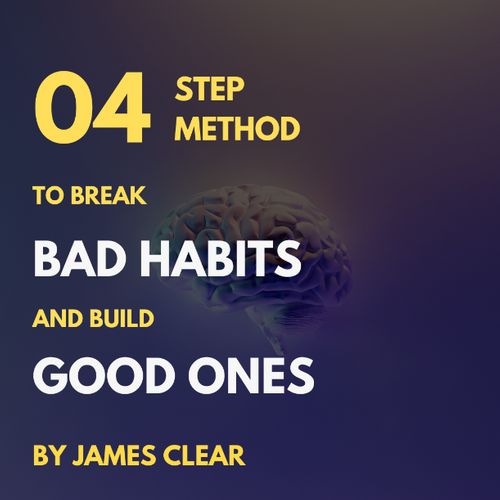4-Step Method By James Clear To Break Bad Habits And Build Good Ones
Mar 29, 2023 · 4 mins read
0
Share

Introduction and Step 1
Our personal and professional lives depend heavily on our habits. A solid set of practices can help us stand out from the crowd and advance in our jobs, health, and interpersonal relationships. In contrast, terrible habits might wreck our lives totally.
Save
Share
The things we do over and over again shape who we are, what we believe, and how we appear to others. Building good habits and eliminating bad ones is challenging. There is a helpful framework that can help us stick to new habits in order to improve major aspects of our lives.
Save
Share
Cue, craving, response, and reward are the fundamental steps that make up the habit-forming process. We can better comprehend what a habit is, how it functions, and how to change it by dissecting it into these basic components.

Save
Share
Every habit, whether good or bad, begins with a cue; cues cause us to begin a particular activity. Cues that stand out are more likely to be seen by us. The cue is the first sign that a reward is coming, and it inevitably causes a craving.
Save
Share
Step 1: Make the cues invisible.
To eliminate bad habits, you must make the cues that lead to them invisible. Redesigning your environment is the most effective way to eliminate cues. Recognize the triggers that cause you to repeat negative behaviors.
Save
Share
Reduce your exposure and remove as many cues from your bad habits as possible from your surroundings. We psychologically link our habits to the places where they take place. Our interactions with the things around us determine our behavior, not the things themselves.
Save
Share
Observing these relationships is important for breaking bad habits and forming good ones because they help in removing triggers that cause bad behaviors and replacing them with triggers that build good habits. In a new environment, habits may be easier to change.
Save
Share
Actionable Insight:
Find an area, corner, or nook in your environment that you rarely use and build a new routine in that area. You are free to explore other places in and around your surrounding to replace bad habits with good ones.
Save
Share
The driving force behind every habit, cravings constitutes the second stage of the habit loop. We have no reason to act unless we have some amount of drive or desire—unless we yearn for a change. Craving is a desire to change your internal state.
Save
Share
When someone feels anxious, one might smoke a cigarette and the other might run or lift weights.
We have an underlying craving to connect with people, which is why scrolling social media feels so satisfying. There is a underlying craving that motivates us to repeat bad behaviors.
Save
Share
0